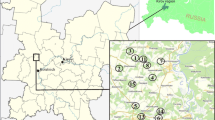Abstract.
The grey mouse lemur (Microcebus murinus) has a dispersed social structure, within which female sleeping associations are common. These sleeping associations have been hypothesised to confer anti-predatory and thermoregulatory benefits, especially when rearing offspring. The genetic composition of these associations was determined using microsatellite markers to test predictions derived from kin selection theory. 161 (99 males, 62 females) individual M. murinus belonging to a free-living population in Ampijoroa, north-western Madagascar, were genotyped and observed over a total of 13 months distributed over the dry seasons of 3 successive years (1995–1997). Kin selection theory predicts that these female associations should consist of closely related members, and that female philopatry and male natal dispersal should characterise the dispersal pattern within this species. These predictions were confirmed by the data. Five out of six female sleeping groups consisted of one or more closely related dyads. Females that slept alone did not have close female kin in the vicinity or within the population at all. Closely related female dyads lived in significantly closer proximity than closely related male dyads and closely related male-female dyads showed intermediate proximity. In combination with the result that females possessed significantly more relatives within the population than males, these findings support the behavioural hypotheses of female philopatry and male natal dispersal. Matrilinear grouping patterns and sex-biased dispersal are therefore genetically established in a dispersed primate social organisation for the first time. The results further indicate that several generations of mouse lemurs live together within a given area, implying both an effective mechanism of kin recognition to avoid father-daughter incest and the potential for social learning to ensure individual recognition.
Similar content being viewed by others

Author information
Authors and Affiliations
Additional information
Electronic Publication
Rights and permissions
About this article
Cite this article
Radespiel, U., Sarikaya, Z., Zimmermann, E. et al. Sociogenetic structure in a free-living nocturnal primate population: sex-specific differences in the grey mouse lemur (Microcebus murinus). Behav Ecol Sociobiol 50, 493–502 (2001). https://doi.org/10.1007/s002650100402
Received:
Revised:
Accepted:
Issue Date:
DOI: https://doi.org/10.1007/s002650100402



